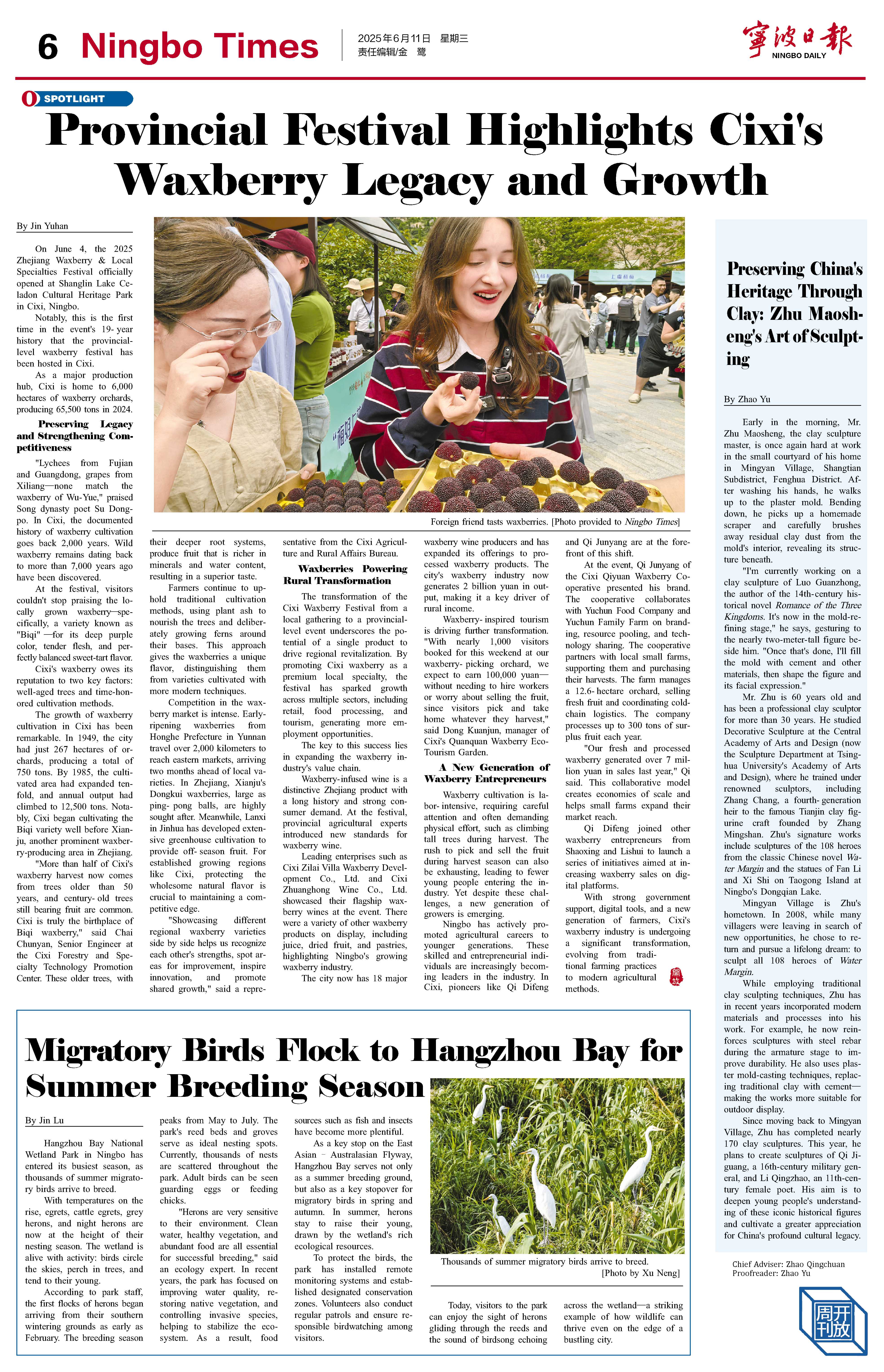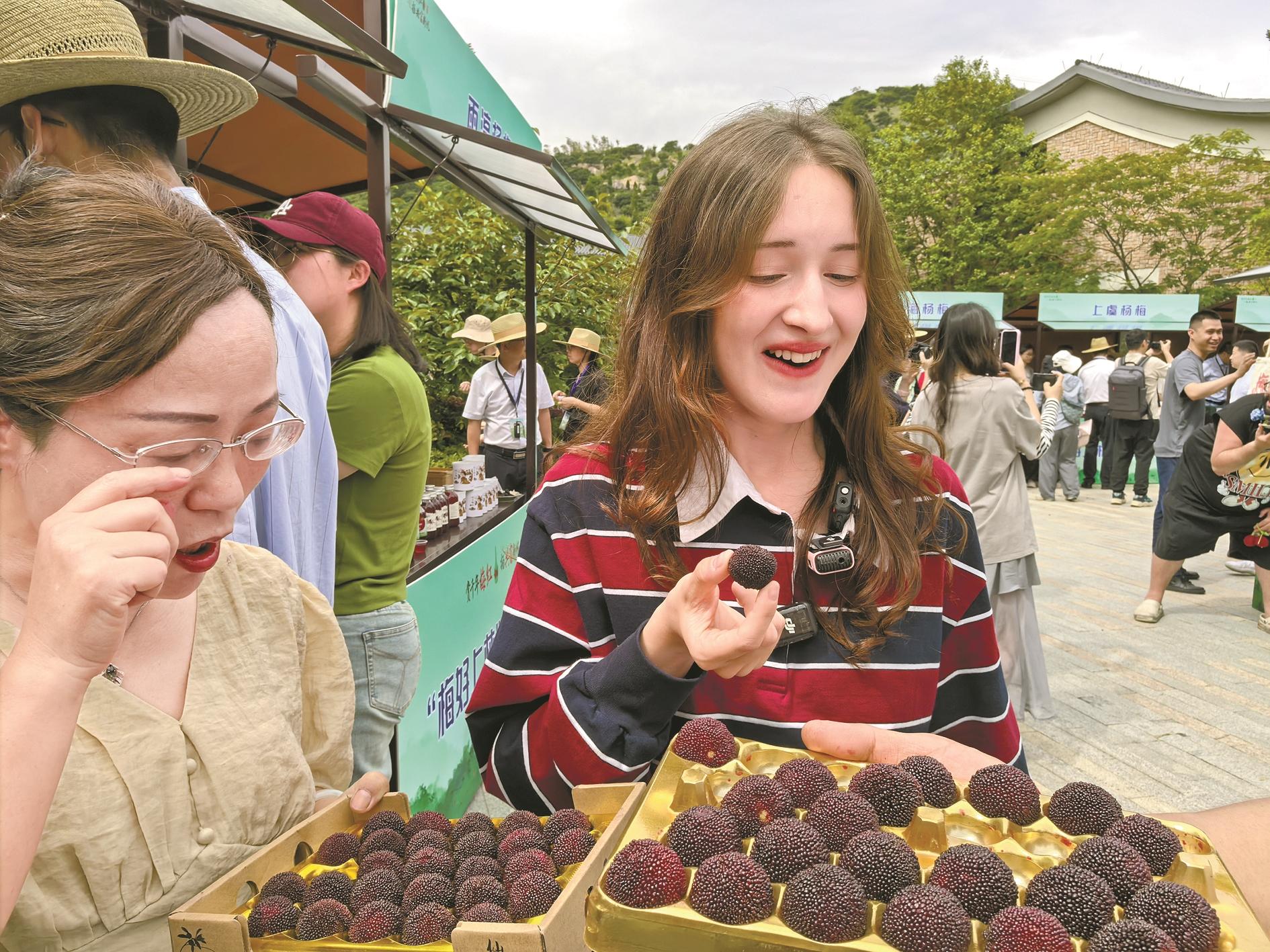By Jin Yuhan
On June 4, the 2025 Zhejiang Waxberry & Local Specialties Festival officially opened at Shanglin Lake Celadon Cultural Heritage Park in Cixi, Ningbo.
Notably, this is the first time in the event's 19-year history that the provincial-level waxberry festival has been hosted in Cixi.
As a major production hub, Cixi is home to 6,000 hectares of waxberry orchards, producing 65,500 tons in 2024.
Preserving Legacy and Strengthening Competitiveness
"Lychees from Fujian and Guangdong, grapes from Xiliang—none match the waxberry of Wu-Yue," praised Song dynasty poet Su Dongpo. In Cixi, the documented history of waxberry cultivation goes back 2,000 years. Wild waxberry remains dating back to more than 7,000 years ago have been discovered.
At the festival, visitors couldn't stop praising the locally grown waxberry—specifically, a variety known as "Biqi"—for its deep purple color, tender flesh, and perfectly balanced sweet-tart flavor.
Cixi's waxberry owes its reputation to two key factors: well-aged trees and time-honored cultivation methods.
The growth of waxberry cultivation in Cixi has been remarkable. In 1949, the city had just 267 hectares of orchards, producing a total of 750 tons. By 1985, the cultivated area had expanded tenfold, and annual output had climbed to 12,500 tons. Notably, Cixi began cultivating the Biqi variety well before Xianju, another prominent waxberry-producing area in Zhejiang.
"More than half of Cixi's waxberry harvest now comes from trees older than 50 years, and century-old trees still bearing fruit are common. Cixi is truly the birthplace of Biqi waxberry," said Chai Chunyan, Senior Engineer at the Cixi Forestry and Specialty Technology Promotion Center. These older trees, with their deeper root systems, produce fruit that is richer in minerals and water content, resulting in a superior taste.
Farmers continue to uphold traditional cultivation methods, using plant ash to nourish the trees and deliberately growing ferns around their bases. This approach gives the waxberries a unique flavor, distinguishing them from varieties cultivated with more modern techniques.
Competition in the waxberry market is intense. Early-ripening waxberries from Honghe Prefecture in Yunnan travel over 2,000 kilometers to reach eastern markets, arriving two months ahead of local varieties. In Zhejiang, Xianju's Dongkui waxberries, large as ping-pong balls, are highly sought after. Meanwhile, Lanxi in Jinhua has developed extensive greenhouse cultivation to provide off-season fruit. For established growing regions like Cixi, protecting the wholesome natural flavor is crucial to maintaining a competitive edge.
"Showcasing different regional waxberry varieties side by side helps us recognize each other's strengths, spot areas for improvement, inspire innovation, and promote shared growth," said a representative from the Cixi Agriculture and Rural Affairs Bureau.
Waxberries Powering Rural Transformation
The transformation of the Cixi Waxberry Festival from a local gathering to a provincial-level event underscores the potential of a single product to drive regional revitalization. By promoting Cixi waxberry as a premium local specialty, the festival has sparked growth across multiple sectors, including retail, food processing, and tourism, generating more employment opportunities.
The key to this success lies in expanding the waxberry industry's value chain.
Waxberry-infused wine is a distinctive Zhejiang product with a long history and strong consumer demand. At the festival, provincial agricultural experts introduced new standards for waxberry wine.
Leading enterprises such as Cixi Zilai Villa Waxberry Development Co., Ltd. and Cixi Zhuanghong Wine Co., Ltd. showcased their flagship waxberry wines at the event. There were a variety of other waxberry products on display, including juice, dried fruit, and pastries, highlighting Ningbo's growing waxberry industry.
The city now has 18 major waxberry wine producers and has expanded its offerings to processed waxberry products. The city's waxberry industry now generates 2 billion yuan in output, making it a key driver of rural income.
Waxberry-inspired tourism is driving further transformation. "With nearly 1,000 visitors booked for this weekend at our waxberry-picking orchard, we expect to earn 100,000 yuan—without needing to hire workers or worry about selling the fruit, since visitors pick and take home whatever they harvest," said Dong Kuanjun, manager of Cixi's Quanquan Waxberry Eco-Tourism Garden.
A New Generation of Waxberry Entrepreneurs
Waxberry cultivation is labor-intensive, requiring careful attention and often demanding physical effort, such as climbing tall trees during harvest. The rush to pick and sell the fruit during harvest season can also be exhausting, leading to fewer young people entering the industry. Yet despite these challenges, a new generation of growers is emerging.
Ningbo has actively promoted agricultural careers to younger generations. These skilled and entrepreneurial individuals are increasingly becoming leaders in the industry. In Cixi, pioneers like Qi Difeng and Qi Junyang are at the forefront of this shift.
At the event, Qi Junyang of the Cixi Qiyuan Waxberry Cooperative presented his brand. The cooperative collaborates with Yuchun Food Company and Yuchun Family Farm on branding, resource pooling, and technology sharing. The cooperative partners with local small farms, supporting them and purchasing their harvests. The farm manages a 12.6-hectare orchard, selling fresh fruit and coordinating cold-chain logistics. The company processes up to 300 tons of surplus fruit each year.
"Our fresh and processed waxberry generated over 7 million yuan in sales last year," Qi said. This collaborative model creates economies of scale and helps small farms expand their market reach.
Qi Difeng joined other waxberry entrepreneurs from Shaoxing and Lishui to launch a series of initiatives aimed at increasing waxberry sales on digital platforms.
With strong government support, digital tools, and a new generation of farmers, Cixi's waxberry industry is undergoing a significant transformation, evolving from traditional farming practices to modern agricultural methods.



